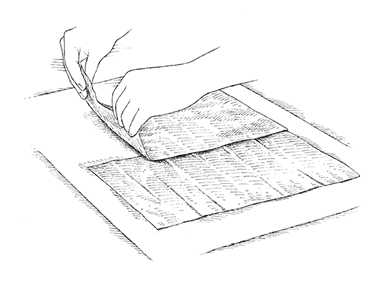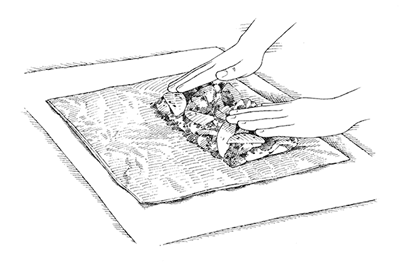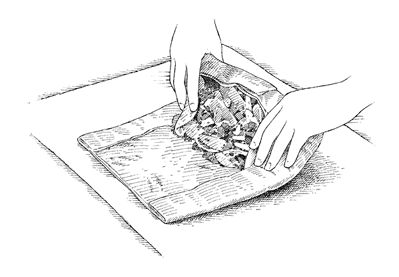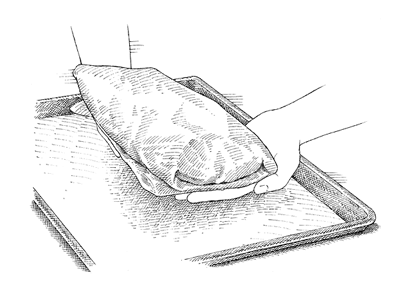The Cook's Illustrated Cookbook (356 page)
Read The Cook's Illustrated Cookbook Online
Authors: The Editors at America's Test Kitchen
Tags: #Cooking

![]() WHY THIS RECIPE WORKS
WHY THIS RECIPE WORKS
Classic apple strudel is an all-day affair. We wanted to see if we could get full apple flavor, a moist filling, and a crisp, flaky crust in less than an hour. From the outset, we shelved the notion of homemade strudel dough; phyllo dough provided a good substitute. For a strudel with a crisp, flaky crust that held its shape, and didn’t dislodge or fly off if we came near it with a fork, we handled the phyllo dough carefully, sprinkling butter and sugar between its layers to form a cohesive crust. For the filling, we used a combination of McIntosh and Golden Delicious apples, cut into thin slices, for maximum flavor and tender bites of apple. Raisins and walnuts added textural interest; plumping the raisins first in apple brandy deepened the apple flavor overall. Browning the bread crumbs in butter for our strudel prevented an overly heavy, bready filling. And baking the strudel in a very hot oven for just 15 minutes crisped the phyllo but didn’t dry it out.
See “ASSEMBLING APPLE STRUDEL” illustrations that follow recipe.
SERVES 6 TO 8
Do not thaw the phyllo dough in the microwave; let it sit in the refrigerator overnight or on the counter for 4 to 5 hours. If the phyllo sheets have small cuts or tears in the same location, flip the alternating sheets of phyllo when assembling the strudel in step 4, so that the cuts will not line up and cause a weak spot in the crust. To make fresh bread crumbs, pulse 1 slice white sandwich bread (with crust) in a food processor to fine crumbs, about 6 pulses; you will have 1 cup fresh bread crumbs. Serve the strudel warm with
TANGY WHIPPED CREAM
or
WHIPPED CREAM
; if you choose to make the tangy whipped cream, make it before starting the strudel because it must stand at room temperature for about 1¹⁄
2
hours before serving.
¹⁄ | cup golden raisins |
2 | tablespoons Calvados or apple cider |
¹⁄ | cup fresh white bread crumbs |
8 | tablespoons unsalted butter, melted and cooled |
1 | pound Golden Delicious apples, peeled, cored, and sliced ¹⁄ |
1 | McIntosh apple, peeled, cored, and sliced ¹⁄ |
¹⁄ | cup walnuts, toasted and chopped fine (optional) |
¹⁄ | cup plus 2 tablespoons (2²⁄ |
1 | teaspoon lemon juice |
¹⁄ | teaspoon ground cinnamon |
¹⁄ | teaspoon salt |
10 | (14 by 9-inch) sheets phyllo, thawed |
1¹⁄ | teaspoons confectioners’ sugar |
1.
Adjust oven rack to lower-middle position and heat oven to 475 degrees. Line rimmed baking sheet with parchment paper. Combine raisins and Calvados in small bowl, cover, and microwave until simmering, about 1 minute. Let sit, covered, until needed.
2.
Toast bread crumbs with 1 tablespoon melted butter in 8-inch skillet over medium heat, stirring often, until golden brown, about 2 minutes; transfer to large bowl.
3.
Drain raisins, discarding liquid. Add raisins, apples, walnuts, if using, ¹⁄
4
cup granulated sugar, lemon juice, cinnamon, and salt to bowl with bread crumbs and toss to combine.
4.
Place large sheet of parchment horizontally on work surface. Lay 1 sheet of phyllo on left side of sheet of parchment, then brush with melted butter and sprinkle with ¹⁄
2
teaspoon sugar. Place another sheet of phyllo on right side of parchment, overlapping sheets by 1 inch, then brush with butter and sprinkle with ¹⁄
2
teaspoon sugar. Repeat with remaining 8 sheets of phyllo, brushing each layer with butter and sprinkling with sugar. Mound filling along bottom edge of phyllo, leaving 2¹⁄
2
-inch border on bottom and 2-inch border on sides. Fold dough on sides over apples. Fold dough on bottom over apples and continue to roll dough around filling to form strudel.
5.
Gently transfer strudel, seam side down, to prepared baking sheet; brush with remaining butter and sprinkle with remaining 1 teaspoon sugar. Cut four 1¹⁄
2
-inch vents on diagonal across top of strudel and bake until golden brown, about 15 minutes, rotating baking sheet halfway through baking. Transfer strudel with baking sheet to wire rack and let cool until warm, about 40 minutes.
6.
Dust with confectioners’ sugar before serving; slice with serrated knife and serve warm or at room temperature.
Substitute 2 tablespoons Poire Williams or other pear liqueur for Calvados and 1¹⁄
2
pounds Bosc pears for apples. Increase lemon juice to 2 teaspoons.

1.
Brush 1 sheet of phyllo with melted butter and sprinkle with sugar. Place another sheet of phyllo next to it, overlapping sheets. Brush with more butter and sprinkle with sugar. Repeat this process 4 times.

2.
Mound filling along bottom edge of phyllo, leaving 2¹⁄
2
-inch border on bottom and 2-inch border on sides.

3.
Fold dough on sides over apples. Fold dough on bottom over apples and continue to roll dough around filling to form strudel.

4.
After strudel has been assembled and rolled, gently lay it seam side down on prepared baking sheet.
![]() WHY THIS RECIPE WORKS
WHY THIS RECIPE WORKS
Tired of the dull-tasting, sticky-sweet Danish you buy at the store? We were, too, so we set out how to make a better version at home. We wanted the real thing—flaky, buttery pastry with a not-too-sweet, real fruit filling. Danish are made using a rich yeasted dough similar to that of croissants with the difference being the addition of egg, which contributes to a richer texture. Turning to the filling, tasters liked the classic cream cheese filling but thought traditional jam fillings were too sweet. A dried fruit puree was the answer, although we needed to plump the fruit (apricots were our favorite) in water to keep them from being too dry. We anticipated that shaping the dough would be a challenge but a ruler and pizza wheel (for a Danish braid) allowed us to cut the dough into even strips that were surprisingly easy to braid. And for individual Danish, shaping was as easy as cutting out squares and folding over two squares to form a pocket. Once the dough was shaped and baked, the application of a light glaze while the pastry was still hot allowed the Danish to soak up the glaze, giving it a final touch of sweetness and a beautiful sheen.
See “SHAPING A DANISH BRAID” illustrations that follow recipe.
See “SHAPING INDIVIDUAL DANISH” illustrations that follow recipe.
MAKES ENOUGH FOR 1 LARGE BRAID OR 9 INDIVIDUAL DANISH
If the dough becomes too warm and sticky to work with, cover it with plastic wrap and let it chill in the refrigerator until firm. When rolling the dough out, sprinkle extra flour over the counter and the rolling pin as needed to keep the dough from sticking. For more information on making turns in the dough, see
“MAKING PUFF PASTRY DOUGH”
.
DOUGH
¹⁄ | cup whole milk, heated to 110 degrees |
1 | large egg |
1¹⁄ | cups (7¹⁄ |
¹⁄ | cup (1³⁄ |
1¹⁄ | teaspoons instant or rapid-rise yeast |
³⁄ | teaspoon salt |
BUTTER SQUARE
12 | tablespoons unsalted butter, cut into 3 equal pieces and chilled |
1 | tablespoon all-purpose flour |
1. FOR THE DOUGH:
Mix milk and egg together in liquid measuring cup. Using stand mixer fitted with dough hook, combine 1¹⁄
4
cups flour, sugar, yeast, and salt on low speed. Slowly add milk mixture and mix until dough comes together, about 2 minutes.
2.
Increase speed to medium-low and knead dough until it forms sticky ball and becomes elastic, about 8 minutes. If, after 5 minutes, dough appears overly sticky and doesn’t come together into ball, add remaining ¹⁄
4
cup flour, 1 tablespoon at a time. Scrape dough into large lightly greased bowl, cover with greased plastic wrap, and refrigerate until chilled, about 1 hour.
3. FOR THE BUTTER SQUARE:
Lay 3 butter pieces side by side on sheet of parchment paper. Sprinkle flour over butter and cover with second sheet of parchment. Gently pound butter with rolling pin until butter is softened and flour is fully incorporated, then roll it into 5-inch square. Wrap butter square in plastic and refrigerate until chilled, about 1 hour.
4.
Roll chilled dough onto 9-inch square on lightly floured counter. Place chilled butter square diagonally in center of dough. Fold corners of dough up over butter square so that corners meet in middle and pinch dough seams to seal.
5.
Using rolling pin, gently tap dough, starting from center and working outward, until square becomes larger and butter begins to soften. Gently roll dough into 11-inch square, dusting with extra flour as needed to prevent sticking. Fold dough into thirds like business letter, then fold rectangle in thirds to form square. Wrap dough in plastic wrap and let rest in refrigerator for 2 hours.
6.
Repeat step 5 and let dough rest in refrigerator for 2 more hours before using.
